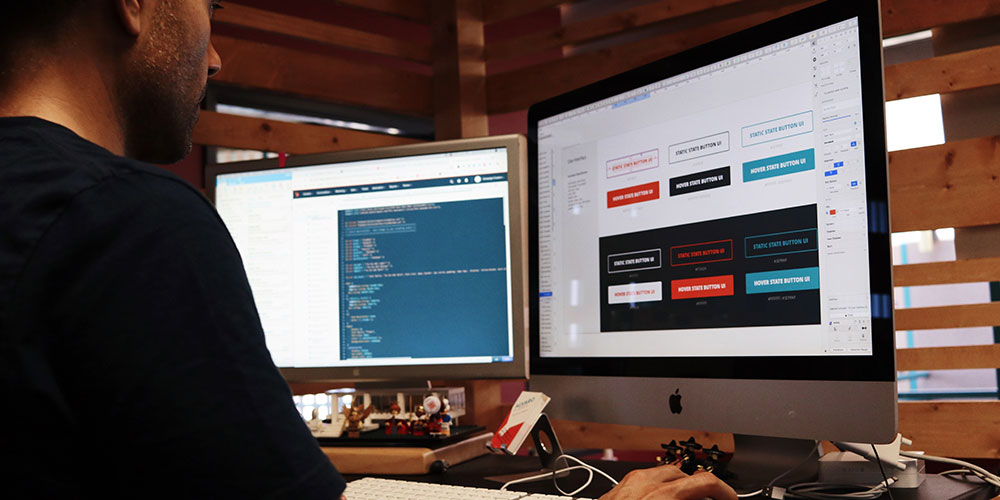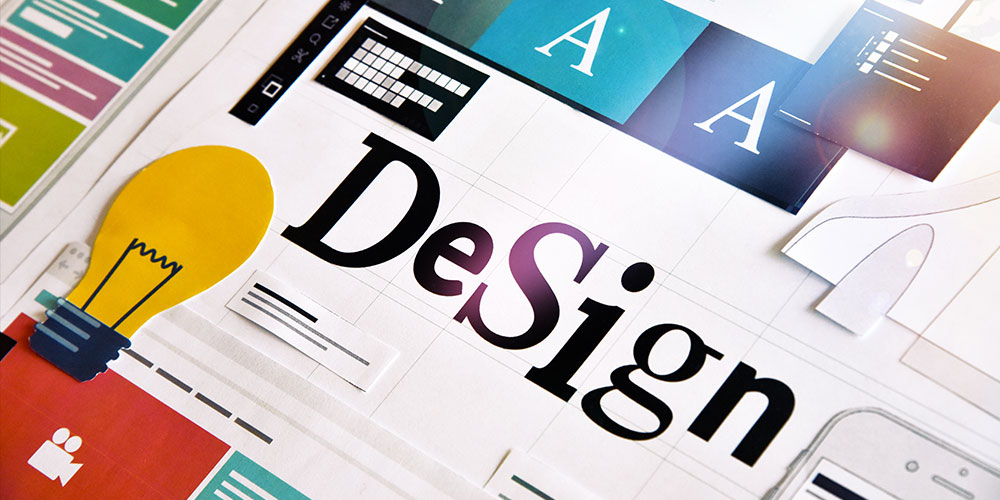Have you ever found yourself asking “How long does it take to design a website?” Whether you are an aspiring business owner seeking an online presence or web designer seeking to streamline workflow, understanding the design process and timeline can be crucial for accelerating projects and meeting deadlines.
In this blog post we’ll look at factors influencing website development timelines, the different phases of the building process, as well as tips for speeding up the design process – let’s dive in!
Short Summary
- Website design timeline varies based on project scope, complexity and customization.
- Experience of designers/developers impacts feasibility, cost & timeline of website projects.
- Clear communication & efficient project management can accelerate the website design process for a high quality result.
Website Design Timeline Factors

The timeline for website design can range from a few days to months, or even years.
This time-span is greatly impacted by various factors such as the project’s complexity and scope, any degree of customization needed, plus the experience of those creating it.
For instance, if you require a simple single page site, that may take no more than twenty four hours, while an elaborate one with lots of custom features might need much longer — up to twelve months in some cases.
When coming up with an idea on how long designing your new website could possibly take, keep in mind these particular criteria which have been mentioned here: project size & detail work required along with who will be accomplishing said tasks at hand, all play influential roles towards setting out achievable deadlines in regards to getting your new site ready for launch!
Project Scope and Goals
The timeline for website design is heavily impacted by the objectives and scope of a project.
This includes its purpose, who it’s meant to reach out to, and any desired features.
As an example, creating a 10-15 page site used as part of marketing efforts can take anywhere from 1-2 months whereas development for a complex web app would be much longer.
Projects that have properly defined goals are easier to work towards.
This way everyone working understands what needs doing & there’s less risk surrounding delays caused during progress periods due to miscommunication or lack of knowledge!
By making sure all aspects concerning the design process are clear, time can also be saved going forward with your plan.
Complexity and Customization
Creating a custom website with advanced capabilities and integrations requires significant time investment in the design process.
A basic website that has fewer elements are comparatively easier to build but web apps require far more detailed consideration for user experience and interface which makes them much more time-consuming to create than regular sites.
Regardless of complexity, irrespective of complexity. Designers must be mindful when working on any project as they all involve an amount of effort from conception through completion.
Designer Experience and Expertise
The capabilities and knowledge of a web designer have an enormous influence on the timeline for website design.
A skilled website developer can optimize their workflow, expediting the process overall.
They usually possess prior projects to review in order to provide direction and avoid complications down the line.
Conversely, novice designers may find it harder due to lack of familiarity with certain techniques or tools.
Consequently, increasing project costs and time taken dramatically. Taking into account both developers’ as well as designer’s expertise has massive implications when considering any given website project’s costliness & duration.
For a more in depth look at costs, see our article “How much do web designers charge?”.
Website Design Phases

The design process for websites is broken down into three main phases that are necessary in order to create the ultimate final product.
These stages include planning and researching, functionality integration, creating visual designs and finally adding the finishing touches before launch.
It’s important to understand these steps so you can properly manage your design project timeline for a successful end result.
To delve deeper into each phase of the website design cycle, it’s crucial to consider their individual effects on how long it takes to finish up designing an entire website from start-to-finish.
Planning and Research
When it comes to website design projects, the planning and research phase is essential in order for things to run efficiently.
It requires acquiring pertinent data, learning about the desired users of your website, and constructing a plan that complements any objectives you may have set out with this project.
Without taking these first steps properly into consideration beforehand, determining how everything will move forward will not be possible. Can become difficult or even hindered altogether.
By becoming knowledgeable on who your target audience is as well as surveying competing sites within similar areas of expertise.
Designers should be able to construct a sitemap which satisfies all user needs while upholding what they initially had planned during their initial designing process.
Functionality Integration
In our experience, adding the functionality needed for the website initially save a lot of headaches down the road.
The reason being, is that sometimes what is set out from the beginning is not logical once it’s being integrated into the site.
This is especially true when it comes to WordPress based websites, because what happens a lot of times is that the plugin you’re looking to add into the site ends up not being compatible with everything else.
By integrating this part of the process first, you ensure that it works the way that it’s intended to, it’s compatible with the other tools that are being used and save you time not having to go back and look for other options that will work well with the site.
Visual Design and Mockups
The visual design and mockups stage is the point in a website development process where its aesthetics start coming together.
Typically designers build out the homepage as well as other web pages, then get input from stakeholders to make sure it meets all project objectives.
Establishing the look and feel impacts how users will essentially engage with the site, so getting it right is vital for encouraging trust in that brand.
Communication is very important during this stage and helps speed up the website build process. What happens sometimes, is that designers don’t get feedback from the client in a timely manner and ends up pushing the completion of the site out much longer than expected.
Once, input from the client is given, the designer / developer will make revisions to the site. It’s likely that the number of revisions will be set up before the project even begins. The number or type of revisions given with vary from company to company. So, it’s important to ask this question to the potential company you’re looking to employ.
The Finishing touches before launch
Once the website has been fully laid out, designed, and all revisions have been made. The designer will go through making any finishing touches before launching the new website.
Some of the finishing touches that are normally made would be:
- Making sure that the website is responsive desktop, tablet and mobile.
- To make sure all images are optimized for performance.
- Checking the spelling and grammar of your content.
- Double checking that the third party tools integrated into the site are still running properly
These are just a few examples of things that need to be done before going live. It can be exciting to want to get your new site out there, but always make sure you run through a checklist for the best possible outcome.
It can be a pain having to go back and make changes and adjustments post-launch, when they could have been addressed before hand.
DIY vs. Professional Design

When it comes to developing a website, there are two ways of going about it: DIY and professional design.
Each option has its advantages and drawbacks that should be taken into account when determining which route is best for the particular project at hand, based on considerations such as cost, resources available and degree of customizability/functionality desired.
In this section, we shall analyze the differences between DIY web development versus employing specialized designers in order to help you decide which approach will satisfy your needs most accurately according to parameters like budgeting or how much customization & features are needed in relation to your specific website endeavor.
Pros and Cons of DIY Design
For those with less resources, DIY website builders are a suitable solution that can be cost-effective and time efficient.
This approach gives you the power to customize or alter elements without relying on an expert web designer for help.
This kind of method may lack professional accuracy and knowledge which professionals provide.
When it comes to bigger projects requiring more customization options, selecting specialized design services might be wiser than attempting a DIY effort due to its complexity in nature.
Pros and Cons of Professional Design
When deciding between DIY and professional design, it depends on the website project scope, budget constraints, and how many resources are needed.
Professional web design can offer a better quality end result that is tailored to your target audience’s needs.
A professional has a lot more experience and has been doing this a lot longer and their insight alone is more valuable when it comes to building out your website properly.
They will know what tools should be used for your specific project and will provide a website that’s easy to scale with your business as it continues to grow.
The potential con of hiring a professional would be the cost. It is going to run slightly higher than doing it yourself, although in the long run it would save you more money.
It could save you more because if it’s not set up properly in the beginning or doesn’t function the way you intended, you will have to go back and eventually hire a pro to make those fixes for you or have it rebuilt in most cases.
Here’s a simple breakdown of the pros and cons:
| DIY Website Design | Professional Website Design | |
|---|---|---|
| Pros | ||
| Cost Effectiveness | High (Can be less expensive) | Can provide higher ROI in the long run |
| Time Efficiency | High (You control the pace) | Variable (Depends on the service provider’s schedule) |
| Customization | High (You control the changes) | High (Professionals can tailor to specific needs) |
| Resource Requirement | Low (Suitable for those with fewer resources) | Variable (Depends on project’s complexity) |
| Cons | ||
| Professional Accuracy | May lack professional touch and accuracy | High (Delivered by experts) |
| Knowledge Requirements | Requires self-learning and understanding of web design | Not required (Professionals bring their expertise) |
| Complexity Handling | May struggle with complex projects | High (Able to handle larger and more complex projects) |
| Cost | Low (Generally more affordable) | High (Can be more costly) |
| Quality | Variable (Depends on individual’s skills) | High (Tailored to target audience’s needs) |
| Scalability | Variable (Depends on individual’s skills and tools used) | High (Professionals have tools and skills for scalable solutions) |
Content Creation Impact

Content creation is an integral part of the website design process.
Developing content that resonates with your audience and successfully drives engagement is essential for a successful website launch.
This is one part of the process that can really slow down the launch of your website, because content is usually the most time consuming things to do, especially for writing copy.
By understanding how important content creation is in web design processes, you can easily plan to meet deadlines required by a given project, all while guaranteeing success when it comes time to officially present your finished website!
Types of Content

When designing a website, it is important to consider the types of content that can be utilized in order to achieve success.
Text-based elements such as blogs, FAQs and glossaries are useful for providing information and engaging users while non-text based options like photographs, videos or audio add visual appeal.
All these pieces work together to create an enjoyable experience on your website, from written copy used informatively all the way through branding which ties everything together thematically.
Content Collaboration and Approval
The design process for a website must factor in the content collaboration and approval stage, as it guarantees that the target audience’s expectations are met.
Getting several perspectives is key to creating successful content and averting potential delays.
Still, this step may also lengthen the entire timeline of production due to needing multiple evaluations from different team members, thus making communication management an essential ingredient for smooth implementation of this part of development.
Tips for Accelerating Website Design

In order to expedite the website design process, it is important to adhere to certain practices.
Establishing clear communication and expectations upfront will help keep everything on track while project management can assist in staying organized throughout the entire effort.
Utilizing existing templates and pre-built elements also allows for a more efficient workflow with an eye towards completing the final product faster.
By following these strategies, designers are able to create high quality websites without sacrificing time or resources along the way.
Clear Communication and Expectations
Optimizing the website design procedure can be greatly facilitated with clear communication and explicit objectives.
Keeping everyone involved in the project updated via open dialogue prevents misunderstandings that may delay progress, making sure everything runs like clockwork from beginning to end.
Maintaining a cooperative atmosphere where all team members are able to share their thoughts encourages transparency and will enable smoother operation of your design process.
Efficient Project Management
Project managers play a crucial role in expediting the website design process, ensuring that it runs smoothly and quickly.
By utilizing project management tools, setting achievable targets and tracking progress efficiently throughout the entire duration of the task, they can make sure everything is done to its fullest potential with no delays.
This way designing websites will become quicker as well as more organized.
Utilizing Templates and Pre-built Elements
Using templates and pre-made components can help reduce the amount of time needed for website design.
Although they may not give you as much customization options compared to a custom created web page, they still offer an efficient base that saves both effort and money during development.
By utilizing these tools instead of starting from scratch, you are able to get yourself a high quality website with your own distinct style, but without requiring lots of hours invested in its laying out process.
Summary
By taking into consideration various aspects such as project scope, complexity, customization and designer experience that all influence the design process timeline for websites.
Effective communication and efficient project management strategies in combination with templates and pre-built elements help streamline this entire website design procedure.
All of these tactics put together will ensure an outcome that is successful according to your desired needs and expectations.
If you’d like to take the guesswork out of it or looking for a professional that is there with you every step of the design and development process, Southtown Web Design can help.
For more information on getting started, contact us today.
Frequently Asked Questions
How long does it take to build a 5 page website?
It typically takes a couple of months to construct a 5-page website.
Specifically, the process consists in dedicating around one month for five pages.
Thus, if you’re looking to build such a site from scratch, be ready to invest about four weeks on it altogether.
If you have all assets ready to go and know exactly what you want, it could possibly be completed in 1 to 2 weeks.
How hard is it to design a website?
Constructing a website involves skill, effort and knowledge.
It requires an in-depth understanding of design principles as well as user experience guidelines and the need to optimize for search engines.
Clearly this is not an easy task. It demands thoughtfulness, hard work and expertise to deliver results that will meet desired standards.
How long does it take to learn and build a website?
Creating a website takes dedication, and may require up to several years of practice.
Enrolling in an intensive bootcamp is the quickest way to gain web development knowledge within 3-4 months.
Online courses are also available for those who need more flexibility or have limited time on their hands.

